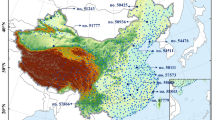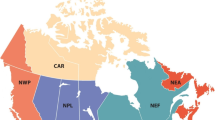Abstract
The rising cases of floods and the onset of drought in different parts of Nigeria require urgent attention particularly because Nigeria accommodates the largest population in Africa, hence any negative climate impact on it can easily ripple into other African regions. To understand the risk factors that drive these extreme events, we study the bivariate extreme cases of monthly precipitation and temperature observations over a period of 116 years (1901–2016). This is the first paper providing bivariate extreme value analysis of data in Nigeria. The mean rainfall and temperature variables exhibit interrelationships such as dry-cold and wet-cold associations. We further investigate whether these relationships are present at the tails by making use of the annual minimum rainfall-annual minimum temperature and annual maximum rainfall-annual minimum temperature pairs. Their extreme dependence structures are also quantified by applying the parametric bivariate extreme value models. Our results show that the compound extremes of dry-cold and wet-cold conditions exhibit a zero to weak extreme dependence at varying quantile levels. A much stronger dependence structure is present between the annual maximum rain and the total volume of rainfall. By considering both independent and dependent probability assumptions, we show that the former may lead to an underestimation of the risks associated with existing climatic hazards. The implications of these results are highlighted throughout the paper.












Similar content being viewed by others
Data Availability Statement
Freely available online at https://sd-webx.worldbank.org
Code availability
evd R package.
References
Abatan, A. A., Abiodun, B. J., Gutowski, W. J., Jr., & Rasaq-Balogun, S. O. (2017). Trends and variability in absolute indices of temperature extremes over Nigeria: Linkage with NAO. International Journal of Climatology, 38, 593–612. https://doi.org/10.1002/joc.5196
Akinbile, C. O., Ogunmola, O. O., Abolude, A. T., & Akande, S. O. (2020). Trends and spatial analysis of temperature and rainfall patterns on rice yields in Nigeria. Atmospheric Science Letters, 21. https://doi.org/10.1002/asl.944
Adedeji, O. H., Odufuwa, B. O., & Adebayo, O. H. (2012). Building capabilities for flood disaster and hazard preparedness and risk reduction in Nigeria: need for spatial planning and land management. Journal of Sustainable Development in Africa, 14, 1520–5509.
Akinsanola, A. A., & Ogunjobi, K. O. (2014). Analysis of rainfall and temperature variability over Nigeria. Global Journal of Human-Social Science B, 14, 11–40.
Bansal, R., & Ochoa, M. (2011). Temperature, aggregate risk, and expected returns. National Bureau of Economic Research Working Paper, 17575.
Burke, M., Miguel, E., Satyanath, S., Dykema, J., & Lobell, D. B. (2009). Warming increases the risk of civil war in Africa. Proceedings of the National Academy of Sciences, 106, 20670–74. https://doi.org/10.1073/pnas.0907998106
Caiy, X., Luz, Y., & Wangx, J. (2018). The impact of temperature on manufacturing worker productivity: evidence from personnel data. Journal of Comparative Economics, 46, 889–905. https://doi.org/10.1016/j.jce.2018.06.003
Chukwudum, Q. C. (2019). Insuring against drought. In: the end of normal. How climate change affects weather patterns and what to do about it. A compendium of essays for the Allianz Climate Risk Research Award, pp 16-17.
Climate Home. (2013). Lake chad’s receding waters linked to European air pollution. Climate Change News. https://www.climatechangenews.com/2013/06/18/lake-chads-receding-waters-linked-to-european-air-pollution. Assessed 5 October 2020,
Coles, S. G. (2001). An Introduction to Statistical Modelling of Extreme Values. London: Springer Series in Statistics.
Cosgrave, J. (2014). Responding to flood disasters: learning from previous relief and recovery operations. ALNAP Lessons Paper. London: ALNAP/ODI.
Dell, M., Jones, B. F., & Olken, B. A. (2012). Temperature shocks and economic growth: evidence from the last half century. American Economic Journal: Macroeconomics, 4, 66–95.
Emodi, E. E. (2013). Drought and desertification as they affect Nigerian environment. Journal of Environmental Management and Safety, 4, 45–54.
FAO. (2020). Nigeria at a glance. FAO in Nigeria. http://www.fao.org/nigeria/fao-in-nigeria/nigeria-at-a-glance/en. Assessed 9 October 2020.
Fisher, R., & Tippett, L. (1928). Limiting Forms of the Frequency Distribution of the Largest or Smallest Member of a Sample. Mathematical Proceedings of the Cambridge Philosophical Society, 24(02), 180–190.
Fjelde, H., & Nv, Uexkull. (2012). Climate triggers: rainfall anomalies, vulnerability and communal conflict in sub-Saharan Africa. Political Geography, 31, 444–53. https://doi.org/10.1016/j.polgeo.2012.08.004
Fuwape, I. A., Ogunjo, S. T., Oluyamo, S. S., & Rabiu, A. B. (2017). Spatial variation of deterministic chaos in mean daily temperature and rainfall over Nigeria. Theoretical and Applied Climatology, 130, 119–132. https://doi.org/10.1007/s00704-016-1867-x
Gbode, I. E., Akinsanola, A. A., & Ajayi, V. O. (2015). Recent changes of some observed climate extreme events in Kano. International Journal of Atmospheric Sciences, 2015, 1–6. https://doi.org/10.1155/2015/298046
Gbode, I. E., Adeyeri, O. E., Menang, K. P., Intsiful, J. D. K., Ajayi, V. O., Omotosho, J. A., & Akinsanola, A. A. (2019). Observed changes in climate extremes in Nigeria. Metrological Applications, 26, 642–654. https://doi.org/10.1002/met.1791
Ikeda, T., Behera, S. K., Morioka, Y., Minakawa, N., Hashizume, M., Tsuzuk, I. A., et al. (2017). Seasonally lagged effects of climatic factors on malaria incidence in south Africa. Scientific Reports, 7, 2458. https://doi.org/10.1038/s41598-017-02680-6
IPCC. (2012). Managing the rising cases of extreme events and disasters to advance climate change adaptation. A special report of working groups I and II of the Intergovernmental Panel on Climate Change. Cambridge UK and New York, USA, Cambridge University Press.
IUCN. (2015). Roots for the future.The landscape and way forward on gender and climate change. Global Gender and Climate Alliance.
Lou, T., Maddock, A., Iceland, C., Ward, P., & Winsemius, H. (2015). World’s 15 countries with the most people exposed to river floods. World resources institute. https://www.wri.org/blog/2015. Assessed 20 September 2020.
Maystadt, J. F., Ecker, O., & Mabiso, A. (2013). Extreme weather and civil war in Somalia: does drought fuel conflict through livestock price shocks? International Food Policy Research Institute Discussion Paper, 01243.
Miguel, E., Satyanath, S., & Sergenti, E. (2004) Economic Shocks and Civil Conflict: An Instrumental Variables Approach. Journal of Political Economy, 112(4): 725-753. https://doi.org/10.1086/421174
Nigeria Post-Disaster Needs Assessment 2012 Floods. (2013). A report by the federal government of Nigeria with technical support from the World Bank, EU, UN, and Other Partners.
OCHA. (2020). Global humanitarian overview 2020. The United Nations Office for the Coordination of Humanitarian Affairs.
Odjugo, P. A. O. (2009). Quantifying the cost of climate change impact in Nigeria: emphasis on wind and rainstorms. Journal of Human Ecology, 28, 93–101.
Odjugo, P. A. O. (2009b). Global and regional analysis of the causes and rate of climate change. Proceeding of the national conference on climate change and Nigerian environment held at the Department of Geography, University of Nsukka, Nsukka, Nigeria, 29th June - 2nd July, 2009.
Ojekunle, Z. O., Oyebamji, F. F., Olatunde, K. A., Amujo, B. T., Ojekunle, V. O., & Sangowusi, O. R. (2014). Global climatic change in Nigeria: A reality or mirage. Global Journal of Human-Social Science: B Geography, Geo-Sciences, Environmental Disaster Management, 14, 10–17.
Olofintoye, O. O., Sule, B. F. (2010). Impact of global warming on the rainfall and temperature in the Niger delta of Nigeria. USEP: Journal of Research Information in Civil Engineering, 7, 33-48.
Oseni, G., Goldstein, M., & Utah, A. (2013). Gender dimensions in Nigerian agriculture. Africa Region Gender Practice Policy Brief No. 6. World Bank.
Salau, O. R., Fasuba, A., Aduloju, K. A., Adesakin, G. E., & Fatigun, A. T. (2016). Effects of changes in ENSO on seasonal mean temperature and rainfall in Nigeria. Climate, 4, 5. https://doi.org/10.3390/cli4010005
Tercula, I. (2015). Desertification: Water scarcity hits Sokoto farmers. https://dailytrust.com/desertification-water-scarcity-hits-sokoto-farmers. Assessed 5 October 2020.
Thomson, M. C., Ukawuba, I., Hershey, C. L., Bennett, A., Ceccato, P., Lyon, B., & Dinku, T. (2017). Using rainfall and temperature data in the evaluation of national malaria control programs in Africa. American Journal of Tropical Medicine and Hygiene., 97, 32–45. https://doi.org/10.4269/ajtmh.16-0696
UNECA. (2015). Assessment report on mainstreaming and implementing disaster risk reduction measures in Nigeria. Ethiopia: Addis Ababa.
WHO. (2012). Public health risk assessment and interventions. Flooding disaster: Nigeria. http://www.who.int/hac/crises/nga/RA_Nigeria_1Nov2012a.pdf. Assessed 20 September 2020.
WHO. (2018). Factsheets: Malaria. https://www.who.int/news-room/factsheets/detail. Assessed October 6 2020.
World Bank Group. (2020). Climate change portal, vulnerability. https://climateknowledgeportal.worldbank.org/country/nigeria. Assessed October 5 2020.
Zivin, J. G., Kahn, M. E. (2014). Industrial productivity in a hotter world: the aggregate implications of heterogeneous firm investment in air conditioning. Working Paper 22962, NBER Working Paper Series, National Bureau of Economic Research, Cambridge.
Funding
No funding was received for conducting this research.
Author information
Authors and Affiliations
Contributions
Queensley C. Chukwudum: Conception of study, acquisition of data, writing, analysis and interpretation of data. Saralees Nadarajah: Design of study, supervision of work and revising it critically for important intellectual content.
Corresponding author
Ethics declarations
Conflict of Interest/Competing Interests
The authors have no conflicts of interest to declare.
Rights and permissions
About this article
Cite this article
Chukwudum, Q.C., Nadarajah, S. Bivariate Extreme Value Analysis of Rainfall and Temperature in Nigeria. Environ Model Assess 27, 343–362 (2022). https://doi.org/10.1007/s10666-021-09781-7
Received:
Accepted:
Published:
Issue Date:
DOI: https://doi.org/10.1007/s10666-021-09781-7




